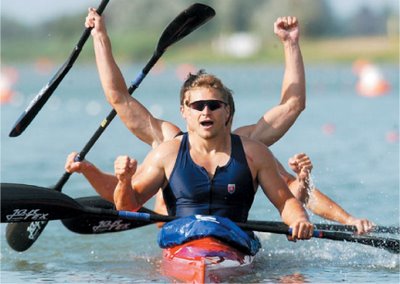 So, over the last month or so, I've been doing a 12.5km Monday morning paddle from the Cooks River boat ramp in Kyeemagh, to Dolls Point in Botany Bay, & back. My aim has been to push a little bit harder than usual, in an effort to get a bit fitter, and also to see if I can discern any speed difference in the various kayaks we at Expedition Kayaks are selling. I cruise 'plus 10%' at about 8.5km/h, which is faster than I would have paddled on any club or instruction trip for the past 3 years. In fact, if I was to head off on a club paddle at this pace I reckon I'd probably exhaust at least half of my fellow paddlers within half an hour.
So, over the last month or so, I've been doing a 12.5km Monday morning paddle from the Cooks River boat ramp in Kyeemagh, to Dolls Point in Botany Bay, & back. My aim has been to push a little bit harder than usual, in an effort to get a bit fitter, and also to see if I can discern any speed difference in the various kayaks we at Expedition Kayaks are selling. I cruise 'plus 10%' at about 8.5km/h, which is faster than I would have paddled on any club or instruction trip for the past 3 years. In fact, if I was to head off on a club paddle at this pace I reckon I'd probably exhaust at least half of my fellow paddlers within half an hour.
Conditions have been pretty much flat & windless, so I haven't had to contend with anything skewing the results of my test times, and the conclusions are really interesting. The Force 5, which really & truly is an amazingly fast boat in sea conditions, is actually only about 300m per hour faster than the Norkapp when paddled on the flat. The Norkapp is not designed for flat water racing - it's a dyed in the wool sea kayak. The Assateague, which I love paddling in anything remotely challenging, but which I would have considered to be a reasonably slow boat on flat water, is only about 100m/hour slower than the Nordkapp on flat water. The Aquanaut, which is blowing away many 5.8m sea kayaks in sea conditions, is only fractionally faster than the Nordkapp, on the flat. Think about those results - effectively it means after 12.5km of paddling at a rate above that which you would find on just about any club or social paddle, these kayaks are all going to arrive at the same destination within about 4 minutes of each other. I have deliberately italicsed the pertinent parts of my analysis, to attempt to show the absolute codswallop that is behind the idea that boat A is fast, & boat B is slow. The simple fact is, if you can get some sea skills through a good commercial instructor like Rob, or in a club environment, you will a) have a more efficient forward stroke and therefore be able to paddle more efficiently (& therefore faster); and b) better be able to take full advantage of the environment around you in the sea, to propel your kayak faster.
A classic example of my speed furphy theory is the Montauk, a boat we sell for smaller paddlers, which is just 16ft long. It is a lovely design, with a Swede form giving it excellent hull speed for it's overall waterline length, but I would again have considered it to be a reasonably slow boat. I took a ski paddler out for a test paddle in the Montauk a few weeks ago - she was small in stature but big on power & technique - and in a 4km return paddle on the sea she had me going well above my comfort level just to keep up (I was in the Currituck, which is another boat that performs beautifully in the sea, but is a bit sluggish on flat water). Anyway, she proved once & for all that the Montauk is definitely not slow in the hands of someone with a good forward paddle technique.
So, think twice about the boat if you're worried about keeping up, or going faster - look instead at your own technique, and think hard about whether you're in the sport to race (in which case, go buy a racing ski, or if you really want to go fast, a Rapier 20), or to smell the roses......



Nice post. There's no point dilating on 2% improvement in boat speed if you can easily make a 20% improvement in your paddling ability through a bit of training. Good work on the shop, BTW.
ReplyDeleteToo right there Brad, it's almost always the engine that is holding back the train, not tyres.....
ReplyDelete